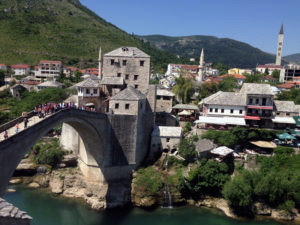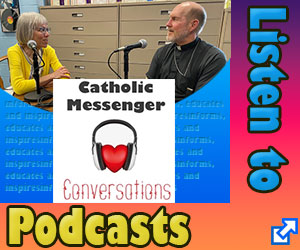(This is part three of a three-part series.)
By Dan Ebener
Note: The following article is based on conversations with friends in Croatia, Bosnia and Serbia. Part I of this series described the religious divide in Croatia. Part II focused on Mostar, a city that is historically Croat but currently a part of Bosnia. In this final segment, we will look at how the religious institutions are doing in Mostar and find a ray of hope for the future.

Mostar sits at the intersection of past empires from the west (Roman), north (Austro-Hungarian), south (Turkish Ottoman) and east (Russian). Each left its mark with its own customs, language, food, dress and religion. Territorial wars have often been misunderstood as religious or ethnic wars in this part of the world.
Since the Bosnia War of 1992-95, the competition between Muslims and Catholics has shifted from the battleground to the church grounds.
During what the locals call “the Communist period,” when Mostar was part of the former Yugoslavia, the political authorities built a Memorial Park to honor those who died in World War II. When the Catholic cathedral was rebuilt, the Communists would not allow the church tower to be higher than the Memorial Park tower.
The Communist period gave way to the Bosnian War, where Croat Catholics, Bosnian Muslims and Serbian Orthodox fought bitterly. In Mostar, it was a hometown war of neighbor against neighbor.
Now the height and number of church towers is grounds for hometown competition. Since the war, churches have built bigger church towers with bigger and louder church bells. The bell-ringing is unlike any place I have traveled. Church bells ring loudly, all over town, every 15 minutes. At 6 a.m., noon and 6 p.m., some church bells ring for 15-20 minutes, tuning into the Angelus as well as songs like, “Tis a gift to be simple.”
Local Catholics say this is in direct response to the Muslim strategy to build more, bigger and louder minarets (towers usually connected to

St. Francis Church Tower is highest point in Mostar, Bosnia, skyline. Old Stone Bridge is on the left.
mosques). Before the war, Mostar had three mosques. Muslim men would climb the stairs on the minarets and read the call to prayer five times per day. Since the war, Mostar has 33 mosques, some of which are free-standing minarets used only as broadcast stations for the call to prayer, which is now transmitted electronically.
The result is a new competition for the airwaves of Mostar. The irony is that most people in Mostar, while holding tightly to their religious identity, do not practice their faith. The majority of both Muslims and Catholics are secular, not religious at all.
Nestled between buildings scarred by the Bosnian War, and the grand mountains surrounding Mostar, St. Francis Church has the highest church tower in this part of Europe. The tower was built precisely to be the highest point in Mostar. The ringing of its bells can be heard all the way up the mountain to the north and across the Old Stone Bridge to the west.
But something else was happening at St. Francis Church. It was the activity inside the church that caught my attention. The energy I witnessed at the 6 p.m. Sunday Mass for young adults was unlike anything I have seen elsewhere in Europe — with the exception of about an hour’s drive up the road — at Medjugorie!
Young adults were singing and praying with enthusiasm, playing and swaying to contemporary church music, lining up for confession and fully participating in the liturgy. This was the greater cause for hope. The broadcasting of church bells versus the Muslim call to prayer seemed like a sideshow. This was a more genuine practice of the Catholic faith.
My hope and prayer for my friends in Mostar — Muslim, Orthodox and Catholic — is that the religious fervor of Medjugorie can catch hold. Given the bloody history of this part of the world, perhaps Our Lady, Queen of Peace can generate a ray of hope for peace.
(Dan Ebener teaches at St. Ambrose University and serves as diocesan director of Stewardship and Parish Planning.)








